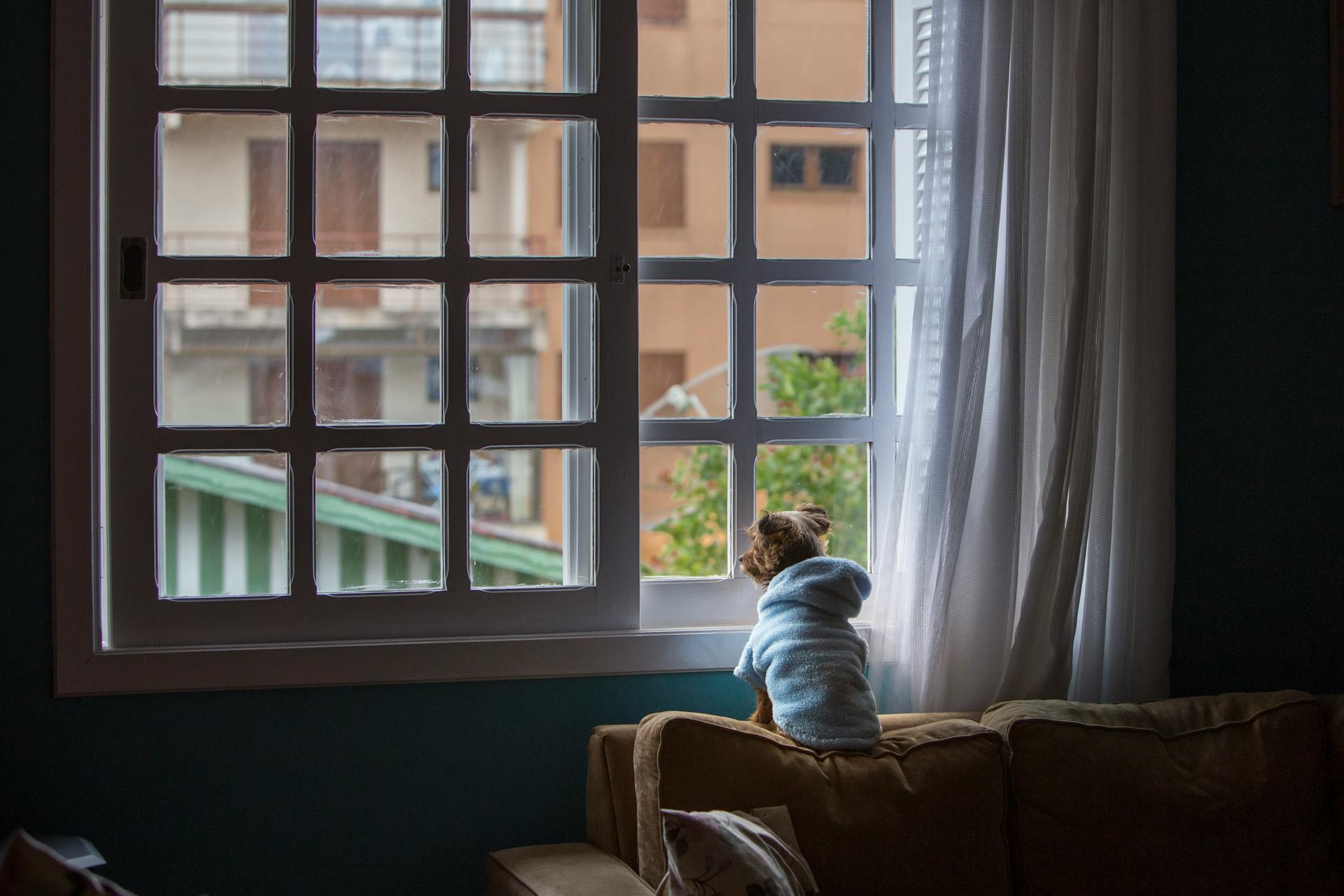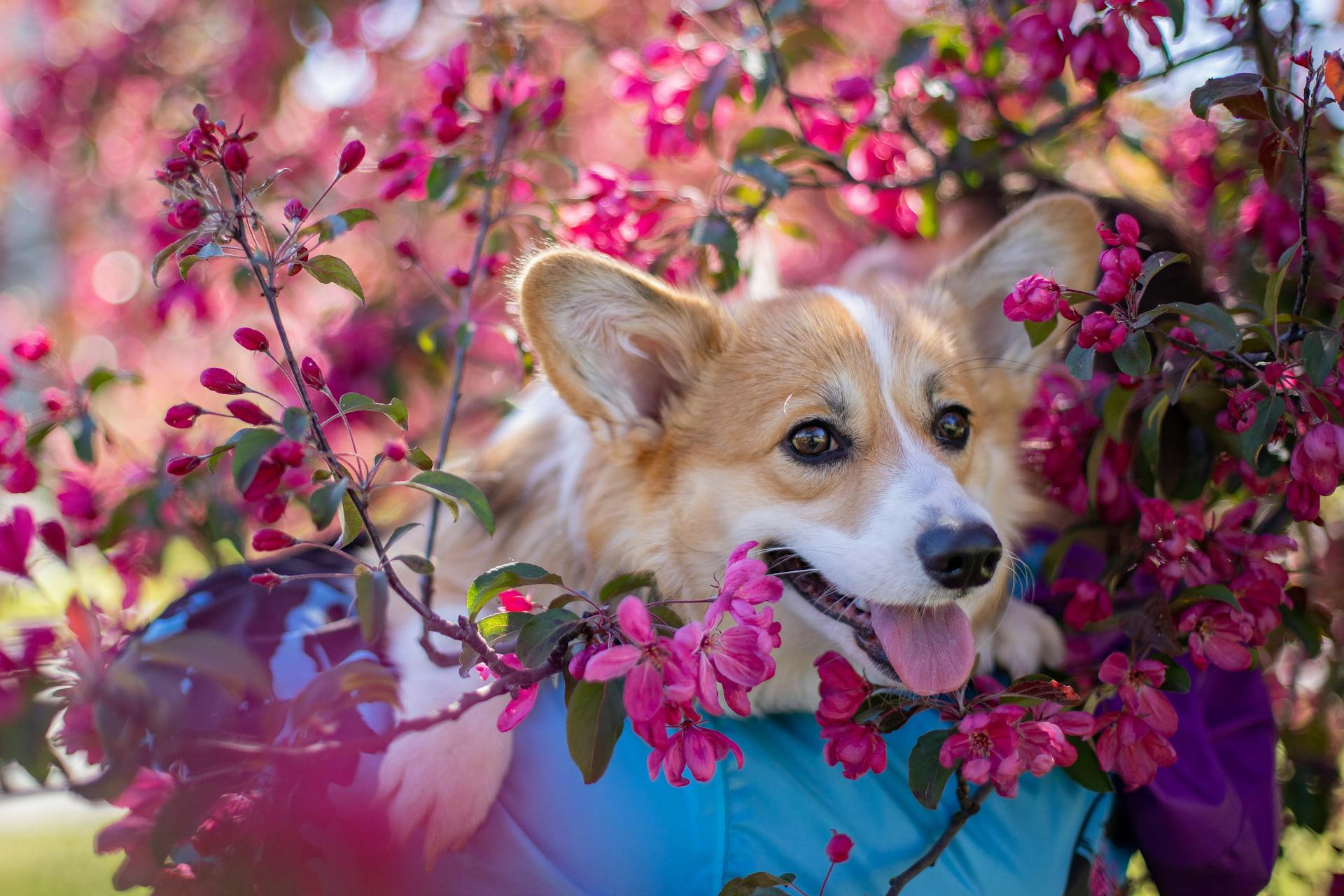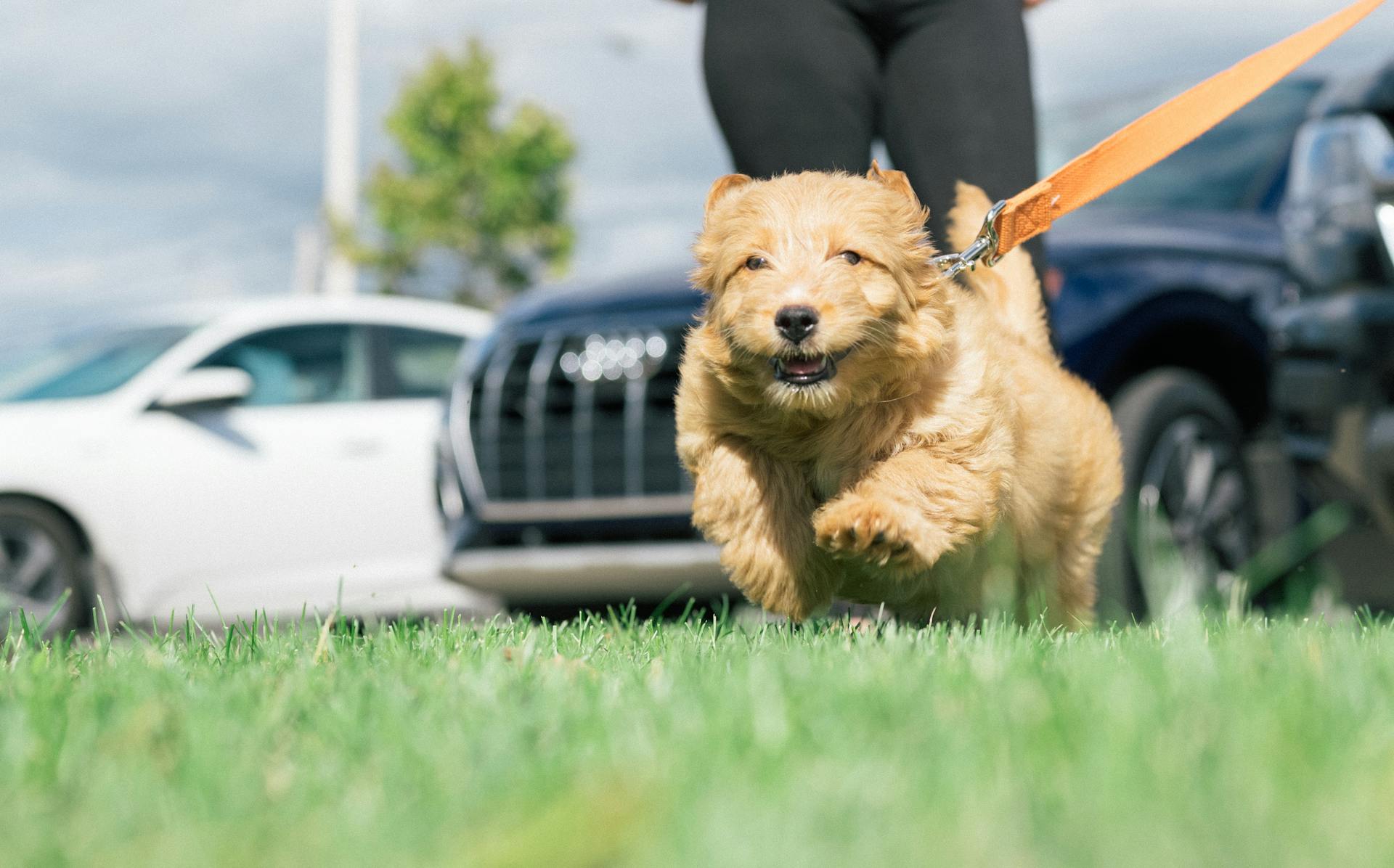
Labradoodles can be left alone, but it's essential to consider their high energy levels and strong attachment to their family. They thrive on interaction and exercise, which can make them prone to separation anxiety if left alone for extended periods.
Labradoodles require a minimum of 1-2 hours of exercise and playtime daily, which can be challenging to provide if you have a busy schedule. Leaving them alone for too long can lead to destructive behavior, such as chewing or digging.
Labradoodles are highly intelligent and trainable, which means they can learn to entertain themselves to some extent. However, they still need regular breaks and attention from their owners.
If you do need to leave your Labradoodle alone, it's crucial to provide them with a safe and comfortable space, such as a crate or a quiet room.
Leaving Your Labradoodle Alone
Leaving your Labradoodle alone requires some planning and preparation to ensure they stay happy and safe at home. You can't simply choose one day to start leaving them alone without a strategic approach or some training.
Broaden your view: Leaving Dog Home Alone While at Work
Labradoodles can be left alone for varying amounts of time depending on their age and setup. Puppies under 6 months should not be left alone for more than 2 hours, while adult dogs can be left alone for 8 hours with proper measures in place.
To create a safe space for your Labradoodle, consider designating a specific area of the house, such as a crate or a quiet room, where they can relax and feel secure.
Leaving the TV or radio on can be a helpful strategy to keep your Labradoodle entertained for hours. This can be especially useful on days when you're away from home for an extended period.
A pet calming diffuser can also be a great tool to reduce stress and anxiety in your Labradoodle. These diffusers use natural ingredients to create a calming environment that can help your dog feel more relaxed.
Here are some factors to consider when deciding how long to leave your Labradoodle alone:
- Age: Puppies under 6 months should not be left alone for more than 2 hours, while adult dogs can be left alone for 8 hours.
- Setup: Consider whether your Labradoodle will be confined or free to roam, and whether they'll have access to food, water, and a comfortable place to rest.
- Training: Gradually increasing the amount of time you leave your Labradoodle alone can help them adjust to being alone and reduce the risk of separation anxiety.
By following these guidelines and considering your Labradoodle's individual needs, you can ensure they stay happy and safe at home even when you're away.
Managing Separation Anxiety
If your Labradoodle has separation anxiety, it's essential to address the issue before leaving them home alone. Dogs with separation anxiety often exhibit destructive behavior, excessive barking or howling, and inappropriate elimination.
Signs of separation anxiety in Labradoodles include defecating and urinating when left alone, barking consistently, and chewing on objects like door frames and windowsills. They may also try to escape by chewing through doors.
To prevent separation anxiety, train your Labradoodle to be independent and comfortable when alone by gradually increasing their time alone and rewarding good behavior. Provide toys and interactive games to distract them and reduce anxiety-based behaviors.
Here are some tips to help your Labradoodle feel calm and comfortable when left alone:
- Create a safe space for your dog to relax in, such as a crate or a quiet room.
- Leave the TV or radio on to provide background noise and keep your dog entertained.
- Use a pet calming diffuser to mimic natural pheromones and help your dog feel calm.
- Don't make a big deal about leaving or returning home, as this can create anxiety for your dog.
- Keep your dog busy with treats, toys, and interactive games to reduce boredom and stress.
- Tire your dog out before leaving the house with a walk or playtime.
- Never punish your dog for destructive behavior, as this can exacerbate anxiety issues.
By following these tips and being aware of the signs of separation anxiety, you can help your Labradoodle feel calm and comfortable when left alone.
Creating a Safe Space
Creating a safe space is crucial for your Labradoodle's well-being when you're away from home. A crate or a designated room can be a great option, as long as it's free from potential hazards like electrical cords or toxic plants.
Labradoodles can relax and stay calm without being scared when they have a safe space, which can be a crate, a specific room, or even a shaded patio. If you plan to confine your dog for 6 to 8 hours, a crate might not be the best choice.
For adult Labradoodles, crate-training can be challenging, so it's essential to start training your pup at an early stage. This way, they'll be comfortable spending time in the crate while you're out and about.
Here are some safe space options for your Labradoodle:
• Crate: A crate can be a good safe space, but make sure it's not used for extended periods (more than 8 hours).
• Designated room: Choose a room where your dog can feel comfortable and secure.
• Shaded patio: A shaded patio can be a great option for your Labradoodle to relax and enjoy the outdoors.
• Living room: A designated area in the living room can also be a safe space for your dog.
Remember, the key is to provide a comfortable and secure space for your Labradoodle to relax and feel safe when you're away.
Recommended read: Training Labradoodles
Keep Your Dog Entertained
Leaving your Labradoodle alone can be challenging, but there are ways to keep them entertained and calm while you're away. You can leave the radio or TV on for your dog to listen to.
Many curated videos on YouTube can create a calm environment for your home-alone dog to enjoy. Choose videos that are specifically designed for dogs.
Playing calm and relaxed music for your pet is another option to keep them entertained. Opt for soothing music instead of fast-paced sounds that might stress your pup out.
You might enjoy: How to Entertain Dog While at Work
Pet Safety Precautions
Leaving a Labradoodle alone requires careful consideration of their safety and well-being.
Labradoodles can develop anxiety-based behaviors if left alone for too long, so it's essential to be aware of any changes in their behavior. Signs of anxiety may include destroyed environments, excessive whining, skittishness, or general fear of their surroundings.
To prevent destructive behavior, provide Labradoodles with plenty of toys and other forms of entertainment. Puzzle feeders can also be used to provide mental stimulation and keep them occupied for longer periods of time.
A safe space is crucial for a Labradoodle's comfort and relaxation. This can be a crate or a designated area like the living room, but it's essential to choose a space that fits their personality and needs.
Adult Labradoodles can be challenging to crate-train, so it's best to start training them at an early stage. If you do need to confine your dog for 6 to 8 hours, consider using a different area, like a shaded patio or a designated room.
Labradoodles should never be left alone for more than 8 hours, even as adults. If you need to be away for longer, make arrangements for someone to check on the dog or take them to a doggy daycare facility.
Here are some potential risks and solutions to consider:
Never punish a Labradoodle for destructive behavior, as this can exacerbate anxiety and fear. Instead, focus on providing a safe and comfortable environment, and rewarding good behavior with treats and praise.
Establish a Routine
Establishing a routine is key to making your Labradoodle feel more secure when left alone. This can include setting a specific time for feeding.
A set time for walking can help your Labradoodle feel more secure and prevent anxiety. This can be as simple as taking them out for a walk at the same time every day.
Setting a routine for playtime can help keep your Labradoodle engaged and entertained while you're away. This can be as short as 15-20 minutes of playtime in the morning and evening.
Providing a consistent daily schedule can help your Labradoodle adjust to being left alone. This can include a set time for feeding, walking, and playtime.
A routine can help reduce destructive behavior in Labradoodles. This can be especially helpful if you have a new puppy or if your Labradoodle is prone to separation anxiety.
Expand your knowledge: Labradoodle
Age and Bladder Control
Puppies under six months old need to go potty every 2 to 4 hours, depending on how old they are. This means you'll need to be near them almost constantly during these early months.
For your interest: Old Dog Losing Eyesight and Hearing
For puppies younger than 6 months old, it's recommended to stay close by so they can frequently relieve themselves. Puppies this age can't hold their pee for as long as adult dogs.
As your Labradoodle grows, you can gradually leave them for a little bit longer. By their first birthday, you can generally leave a Labradoodle in their crate or at home alone for up to 8 hours.
A different take: Cockapoo Puppy Price
Age Impact
Puppies under six months old can't hold their pee for as long as adult dogs, so they need to go potty every 2 to 4 hours.
As your Labradoodle grows, you can gradually leave them alone for longer periods. By their first birthday, you can leave them in their crate or at home alone for up to 8 hours.
Older Labradoodles may need to go potty more frequently than younger adults since they often become incontinent. This is something to consider as your furry friend ages.
Curious to learn more? Check out: House Training a Dog in an Apartment
It's Not Just About Bladder Control

Labradoodles may suffer from separation anxiety if left alone for too long, which can start as early as puppyhood.
Their energetic nature means they need at least 8 hours a day with you, besides sleeping, to spend on activities like swimming, running, or playing fetch.
Leaving them for longer than you should can increase their risk of developing anxiety since you've essentially broken their trust.
Coming home and then promptly leaving again can be just as detrimental, so try to make the most of your time together.
They'll be happy to indulge you with a nap or a snuggle once the adventures are over.
You might like: Crate Dog during Work Day
Alternatives and Solutions
If your Labradoodle has separation anxiety or you can't bear the thought of them being home alone, there are alternatives to consider. You can hire a dog walker to take your pup out for a stroll during the day, or pay more for a dog sitter to look after your pet while you're gone.
You can also ask a friendly neighbor to pop in every few hours to check if everything is okay, or if you live with your family, other family members can take care of your dog while you're away. This way, your Labradoodle will get the social interaction they crave.
If none of these options are possible, you can look for pet daycare centers in your area. Most of these places have training and socialization programs too, which can be a great way to keep your dog busy while you're off at work.
Providing your Labradoodle with plenty of toys and other forms of entertainment can also help keep them occupied while alone. Puzzle feeders can be used to provide mental stimulation and keep them entertained for longer periods of time.
It's recommended to hire a pet sitter or dog walker to check on your dog and provide them with some human interaction if you need to leave them alone for an extended period of time. This can help prevent destructive behavior and other serious issues.
Labradoodles should never be left alone for more than 8 hours, even as adults. If you need to be away for longer than this, it's best to make arrangements for someone to check on your dog or take them to a doggy daycare facility.
For more insights, see: Are Husky Good Family Dogs
Sources
- https://www.dogster.com/dog-health-care/can-a-labradoodle-be-left-alone
- https://texasaustralianlabradoodles.com/2023/04/15/how-to-manage-your-labradoodles-separation-anxiety/
- https://blog.tryfi.com/labradoodle-left-alone-tips/
- https://www.hepper.com/can-labradoodles-be-left-alone-at-home/
- https://www.oodlelife.com/can-labradoodles-be-left-alone/
Featured Images: pexels.com


